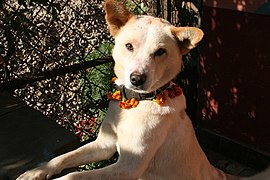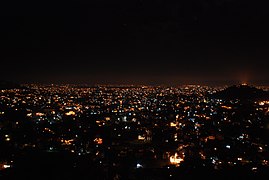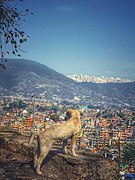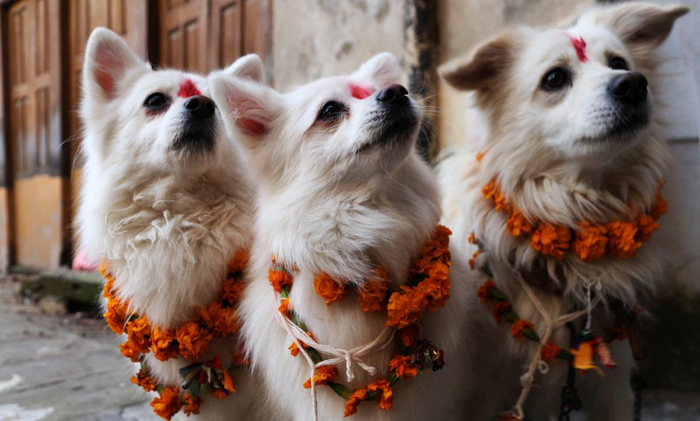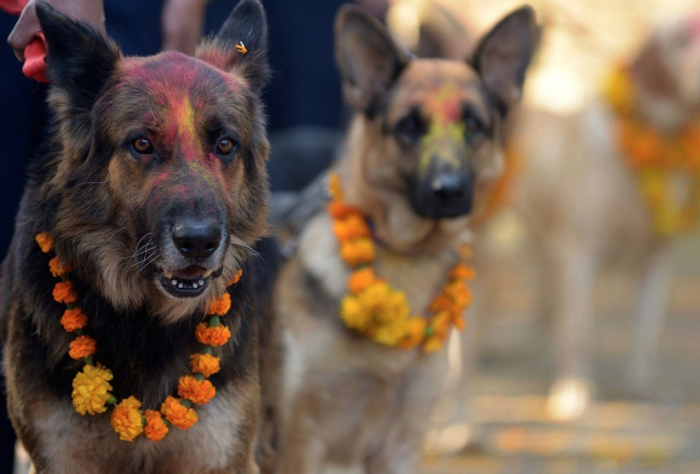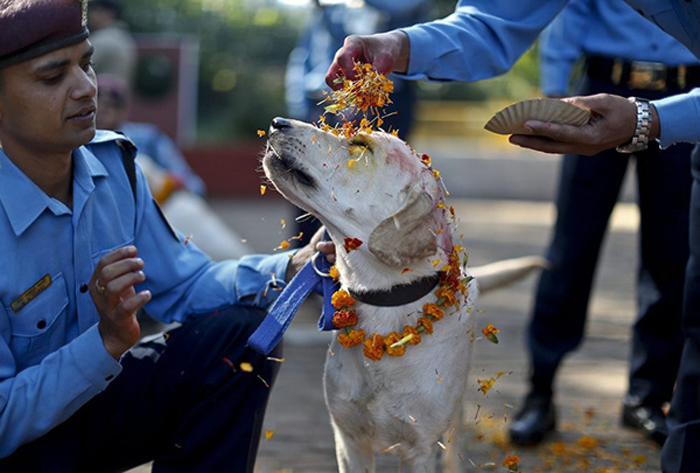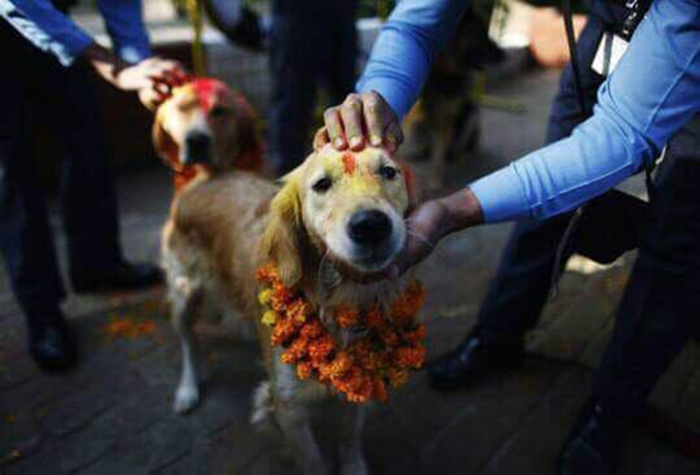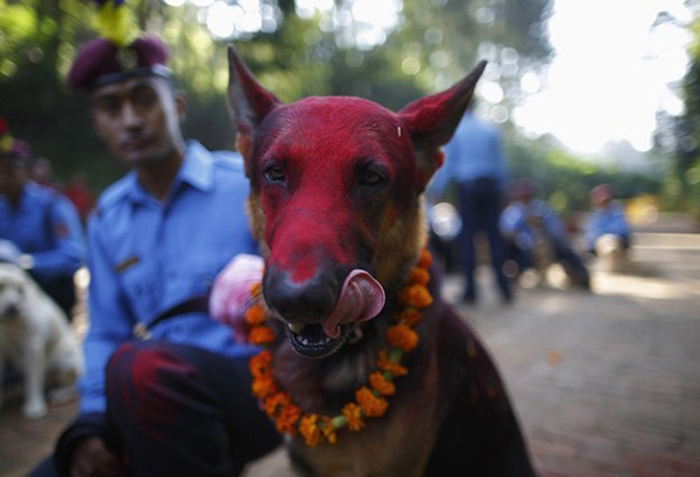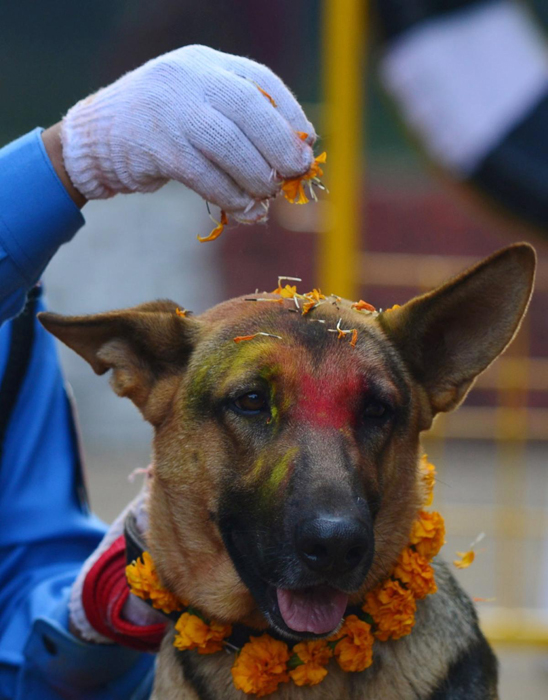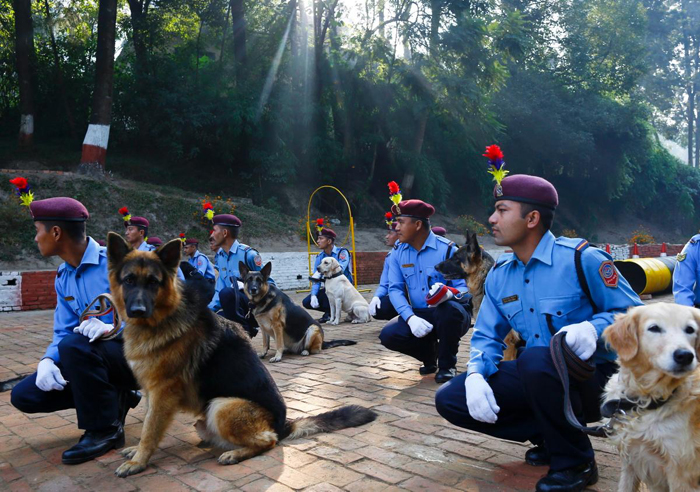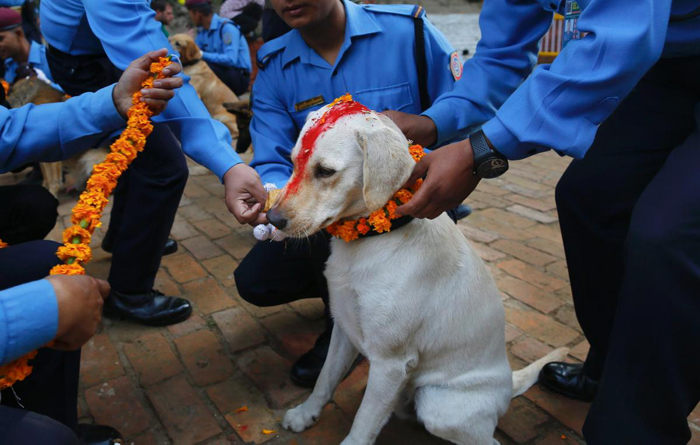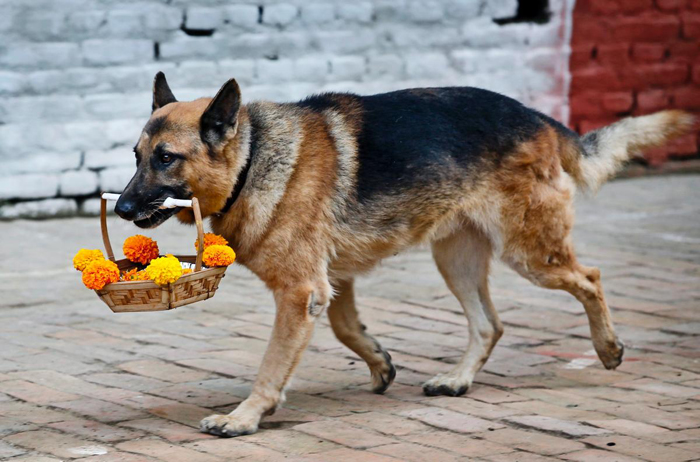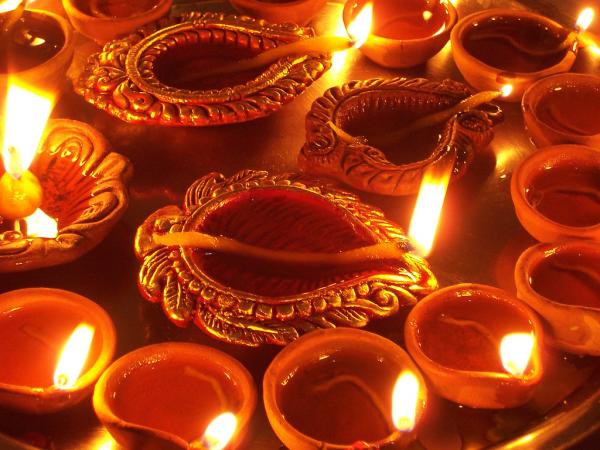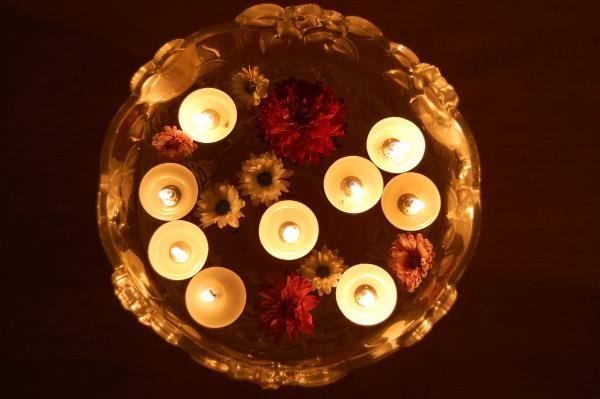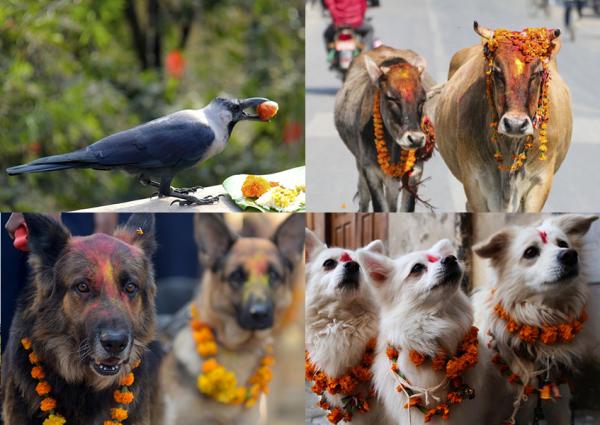From Wikipedia, the free encyclopedia
(Redirected from Kukur Puja)
| Kukur Tihar | |
|---|---|
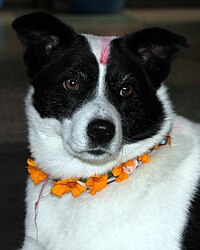
Dog bedecked with flower garlands |
|
| Official name | कुकुर तिहार |
| Also called | Festival of Dogs |
| Type | Religious |
| Celebrations | Honouring dogs |
| Observances | Prayers and religious rituals |
| Date | Kārtika māsa kṛṣṇa pakṣa chaturdashi tithi |
| 2022 date | 24 October 2022 |
| Frequency | Annual |
Kukur Tihar (also called Narak Chaturdashi, Nepali: कुकुर तिहार) is an annual Hindu festival originating from Nepal which falls on the second day of the festival of Tihar (around October or November). On this day, people worship dogs to please Yama, the god of death, as they are considered to be his messengers. Dogs are decorated with tilaka and wear flower garlands around their necks. Worshippers offer them various foods including meat, milk, eggs, and dog food. It is considered a sin if someone acts disrespectfully to a dog on this day.
Kukur Tihar is also celebrated worldwide by the Nepalese diaspora.
Background[edit]
Tihar is a five-day-long Hindu festival originating from Nepal; it is the second-largest festival in the country, after Dashain.[3][4][5] Kukur Tihar is celebrated on the second day of Tihar.[4][6] During the festival of Tihar, many animals including cows and crows are also worshipped.[7][8]
In the ancient Sanskrit epic Mahabharata, the five Pandavas on their way to heaven are accompanied by a dog.[9] The five Pandavas with their wife Draupadi and brothers climb the Himalayas; all of them except Yudhishthira and his dog perishing along the way.[10] Then Yudhishthira meets Indra, King of the gods, who welcomes him to heaven but tells him he has to leave his dog behind.[10][11] Yudhishthira refuses to enter heaven without his dog and says he will go back to earth.[10][12][13] The dog disappears and it is replaced by Yama, the god of death; Indra is impressed by his actions and then his righteousness opens the gates of heaven for Yudhishthira.[10][11]
In Hindu mythology, Yama has two dogs—Shyama and Sharvara—who guard the door of hell.[14] Nepali Hindus believe that by worshipping dogs they start to see death positively, because a dog follows them in their final journey.[15] They hope that dogs will guard them against the torture in hell.[15] Dogs are considered to be a companion of Yama and to please him, dogs are worshipped.[4][16]
According to ABC Science, dogs might have been first domesticated in Nepal and Mongolia.[17]
Celebrations[edit]
|
Hindu festival dates The Hindu calendar is lunisolar but most festival dates are specified using the lunar portion of the calendar. A lunar day is uniquely identified by three calendar elements: māsa (lunar month), pakṣa (lunar fortnight) and tithi (lunar day). Furthermore, when specifying the masa, one of two traditions are applicable, viz. amānta / pūrṇimānta. Iff a festival falls in the waning phase of the moon, these two traditions identify the same lunar day as falling in two different (but successive) masa. A lunar year is shorter than a solar year by about eleven days. As a result, most Hindu festivals occur on different days in successive years on the Gregorian calendar. |
|
Tihar is celebrated around October or November every year.[18] During the festival, dogs are worshipped, bathed, and decorated with tilaka, which is made from kumkuma or gulal powders with rice and yoghurt.[15][19] Flower garlands are draped around their necks and they are offered food including meat, milk, eggs, and dog food.[4] Police dogs and stray dogs are also honoured.[20] Kukur Tihar also celebrates the relationship between dogs and humans.[21] It is considered a sin if someone behaves disrespectfully to a dog on this day.[22]
Reception[edit]
After the April 2015 Nepal earthquake, Animal Nepal used the occasion of the festival to promote awareness about dogs who became homeless.[20] The Kathmandu Post reported that people were buying foreign breeds of dogs which left the local dogs in the streets.[23]
Kukur Tihar spread around Mexico in 2016 to make people aware of respecting animals.[24] Special Broadcasting Service reported that many Nepalis in Australia were also celebrating the festival.[25][26] In 2008. Asian Art in London celebrated the festival by creating a dog walk charity event.[27] Also in 2016, Kathmandu Metropolitan City with the help of Humane Society International and Jane Goodall Institute Nepal created a program to «humanely manage urban dog population».[28] An educational assessment done by International Companion Animal Management Coalition (ICAM Coalition) found that dogs in the capital of Nepal were «generally healthy and accepted by the community».[29]
In 2018, a dog named Kushal was named «The Best Dog of the Year» by the Nepal Police on the occasion of the festival after the dog helped discover the murderer of a 10-year-old girl.[30]
After the Chinese Lychee and Dog Meat Festival, in which festival-goers eat dog meat and lychees, garnered international outrage, One Green Planet described Kukur Tihar as «[it] will restore your faith in humanity».[31] People on social media contrasted the Chinese festival with Kukur Tihar and The Dodo reported that «[it gave] heartbroken dog lovers a reason to feel hopeful again».[32] In a 2016 newspaper article, the President of Animal Nepal appealed to Nepalis «to take a pledge this Kukur Tihar, to not just worship your pets on this day but to do the right thing for them all year round. Unchain and uncage your dogs, learn to interact with them, take them for walks, understand their feelings, …»[33] A 2007 BBC photo essay also pointed out the need to improve the treatment of Nepali dogs which, «during the rest of the year, are not generally well treated…»[34]
Gallery[edit]
-
Dog bedecked with flower garlands
-
Kukur Tihar is celebrated on the second day of five–day Tihar festival, a day before Dipawali.
-
The feet and forehead of dog are adorned with a red tika
-
Alongside pet dogs, stray dogs are also worshipped on this day.
See also[edit]
- Tihar
- Dashain
- Ghode Jatra
References[edit]
- ^ «Kukur Tihar, Laxmi Puja being observed today amid COVID-19 pandemic». The Himalayan Times, 14 November 2020. Retrieved 14 November 2020
- ^ «२०७८ सालको तिहारपर्व सँग सम्वन्धित दिन तथा साईतहरू». Nepal Panchanga Nirnayak Samitee (in Nepali). Retrieved 1 November 2021.
{{cite web}}: CS1 maint: url-status (link) - ^ «Market in border area bustling». The Himalayan Times. 9 November 2020. Retrieved 10 November 2020.
- ^ a b c d «Nepal festival celebrates ‘day of the dogs’«. BBC. 6 November 2018. Archived from the original on 27 October 2020. Retrieved 27 October 2020.
- ^ Prasain, Krishana (21 October 2020). «Nepal’s biggest festival Dashain fails to lift the market mood, buyers and sellers say». The Kathmandu Post. Archived from the original on 10 November 2020. Retrieved 10 November 2020.
- ^ Devleesschauwer, Brecht; et al. (12 February 2016). «Epidemiology, Impact and Control of Rabies in Nepal: A Systematic Review». PLOS Neglected Tropical Diseases. 10 (2): e0004461. doi:10.1371/journal.pntd.0004461. ISSN 1935-2735. PMC 4752342. PMID 26871689.
- ^ Kelly, Erin (5 October 2015). «In Nepal, Every Dog Has Its Day. Literally». All That’s Interesting. Archived from the original on 27 October 2020. Retrieved 27 October 2020.
- ^ Devkota, Mahima (3 November 2021). «Why do we worship crows and dogs?». The Rising Nepal. Archived from the original on 3 November 2021. Retrieved 21 November 2021.
- ^ Shahani, Shradha (22 October 2019). «In Nepal, Diwali is a time to worship the dogs». Condé Nast Traveller. Archived from the original on 27 October 2020. Retrieved 27 October 2020.
- ^ a b c d Vajpeyi, Ananya (29 June 2019). «Epic lessons for Kali Yuga: Rereading the ‘Mahabharata’ in our contemporary moment». The Hindu. ISSN 0971-751X. Archived from the original on 27 October 2020. Retrieved 27 October 2020.
- ^ a b Singh, Sudeshna (8 April 2020). «Interested in the Mahabharata? Know how the Pandavas died». Times Now. Archived from the original on 27 October 2020. Retrieved 27 October 2020.
- ^ Das, Gitanjali (6 September 2020). «Explained: After Modi’s push, a look at the several dog breeds native to India». The Indian Express. Archived from the original on 27 October 2020. Retrieved 27 October 2020.
- ^ «Day of the Dog: A day before Diwali, Nepal celebrates ‘dog puja festival’ with fervour – See pics». Times Now. 7 November 2018. Archived from the original on 27 October 2020. Retrieved 27 October 2020.
- ^ «Dogs worshipped on Kukur Tihar». The Kathmandu Post. 10 November 2015. Archived from the original on 27 October 2020. Retrieved 27 October 2020.
- ^ a b c Marak, Queenbala; Chaudhuri, Sarit K. (28 February 2020). The Cultural Heritage of Meghalaya. Routledge. ISBN 978-1-000-07182-5. Archived from the original on 28 October 2020. Retrieved 28 October 2020.
- ^ «Kukur Tihar, Laxmi Puja observed; Bhai Tika tomorrow». The Himalayan Times. 28 October 2019. Archived from the original on 27 October 2020. Retrieved 27 October 2020.
- ^ Images, Timothy Allen/Getty (20 October 2015). «Dogs may have been first domesticated in Nepal and Mongolia». ABC News. Australian Broadcasting Corporation. Archived from the original on 27 October 2020. Retrieved 27 October 2020.
- ^ Dahal, Phanindra (2 October 2020). «Covid: God may punish Nepal for cancelling rites, religious leaders warn». BBC. Archived from the original on 28 October 2020. Retrieved 28 October 2020.
- ^ «Did you know there is a dog puja festival in Nepal on Choti Diwali day?». The Indian Express. 18 October 2017. Archived from the original on 27 October 2020. Retrieved 27 October 2020.
- ^ a b «Dogs in Nepal enjoy treats, affection». Gulf Times. 30 October 2016. Archived from the original on 14 November 2016. Retrieved 27 October 2020.
- ^ Whitehead, Joanna (8 November 2018). «This Nepalese festival has an entire day devoted to celebrating dogs». The i. Archived from the original on 27 October 2020. Retrieved 28 October 2020.
- ^ Mayol, Taylor (20 October 2015). «All Dogs Go to Heaven … in Nepal». OZY. Archived from the original on 27 October 2020. Retrieved 27 October 2020.
- ^ «Kukur Puja for rescued dogs». The Kathmandu Post. Archived from the original on 28 October 2020. Retrieved 28 October 2020.
- ^ «Mexico adopts Kukur Tihar». Nepali Times. 12 November 2018. Archived from the original on 27 October 2020. Retrieved 27 October 2020.
- ^ «Every dog has its ‘favourite’ day in Nepal». SBS. Archived from the original on 27 October 2020. Retrieved 27 October 2020.
- ^ ««Happy Dog Day»: Nepalis in Australia celebrate their favorite companion for a Hindu festival». SBS. Archived from the original on 27 October 2020. Retrieved 27 October 2020.
- ^ Moore, Susan (1 November 2008). «Asian art market: Asian Art in London offers up an extraordinary range of works from every corner of the continent. Susan Moore selects some highlights». Apollo. 168 (559): 108–110. Archived from the original on 28 October 2020. Retrieved 28 October 2020.
- ^ «Nepal’s First Metropolitan Dog Management Program – «Manumitra» – Launched in Kathmandu». Humane Society International. 20 April 2016. Archived from the original on 27 October 2020. Retrieved 27 October 2020.
- ^ Kartal, Tamara (29 July 2019). «Manu Mitra: an example of community engagement in Kathmandu, Nepal». ICAM. Archived from the original on 27 October 2020. Retrieved 27 October 2020.
- ^ «‘Special 78’ sniff out murderers for Nepal Police». The Kathmandu Post. Archived from the original on 28 October 2020. Retrieved 28 October 2020.
- ^ «Mad About the Yulin Dog Meat Festival? This Festival in Nepal Will Restore Your Faith in Humanity». One Green Planet. 29 June 2015. Archived from the original on 27 October 2020. Retrieved 27 October 2020.
- ^ Schweig, Sarah V. (26 June 2015). «Dogs Thanked For Friendship And Loyalty in Most Beautiful Festival». The Dodo. Archived from the original on 27 October 2020. Retrieved 28 October 2020.
- ^ «The essence of Kukur Tihar». The Himalayan Times. 29 October 2016. Archived from the original on 27 October 2020. Retrieved 27 October 2020.
- ^ «In pictures: Nepal dogs honoured». BBC. 8 November 2007. Archived from the original on 28 October 2020. Retrieved 28 October 2020.
From Wikipedia, the free encyclopedia
(Redirected from Kukur Puja)
| Kukur Tihar | |
|---|---|

Dog bedecked with flower garlands |
|
| Official name | कुकुर तिहार |
| Also called | Festival of Dogs |
| Type | Religious |
| Celebrations | Honouring dogs |
| Observances | Prayers and religious rituals |
| Date | Kārtika māsa kṛṣṇa pakṣa chaturdashi tithi |
| 2022 date | 24 October 2022 |
| Frequency | Annual |
Kukur Tihar (also called Narak Chaturdashi, Nepali: कुकुर तिहार) is an annual Hindu festival originating from Nepal which falls on the second day of the festival of Tihar (around October or November). On this day, people worship dogs to please Yama, the god of death, as they are considered to be his messengers. Dogs are decorated with tilaka and wear flower garlands around their necks. Worshippers offer them various foods including meat, milk, eggs, and dog food. It is considered a sin if someone acts disrespectfully to a dog on this day.
Kukur Tihar is also celebrated worldwide by the Nepalese diaspora.
Background[edit]
Tihar is a five-day-long Hindu festival originating from Nepal; it is the second-largest festival in the country, after Dashain.[3][4][5] Kukur Tihar is celebrated on the second day of Tihar.[4][6] During the festival of Tihar, many animals including cows and crows are also worshipped.[7][8]
In the ancient Sanskrit epic Mahabharata, the five Pandavas on their way to heaven are accompanied by a dog.[9] The five Pandavas with their wife Draupadi and brothers climb the Himalayas; all of them except Yudhishthira and his dog perishing along the way.[10] Then Yudhishthira meets Indra, King of the gods, who welcomes him to heaven but tells him he has to leave his dog behind.[10][11] Yudhishthira refuses to enter heaven without his dog and says he will go back to earth.[10][12][13] The dog disappears and it is replaced by Yama, the god of death; Indra is impressed by his actions and then his righteousness opens the gates of heaven for Yudhishthira.[10][11]
In Hindu mythology, Yama has two dogs—Shyama and Sharvara—who guard the door of hell.[14] Nepali Hindus believe that by worshipping dogs they start to see death positively, because a dog follows them in their final journey.[15] They hope that dogs will guard them against the torture in hell.[15] Dogs are considered to be a companion of Yama and to please him, dogs are worshipped.[4][16]
According to ABC Science, dogs might have been first domesticated in Nepal and Mongolia.[17]
Celebrations[edit]
|
Hindu festival dates The Hindu calendar is lunisolar but most festival dates are specified using the lunar portion of the calendar. A lunar day is uniquely identified by three calendar elements: māsa (lunar month), pakṣa (lunar fortnight) and tithi (lunar day). Furthermore, when specifying the masa, one of two traditions are applicable, viz. amānta / pūrṇimānta. Iff a festival falls in the waning phase of the moon, these two traditions identify the same lunar day as falling in two different (but successive) masa. A lunar year is shorter than a solar year by about eleven days. As a result, most Hindu festivals occur on different days in successive years on the Gregorian calendar. |
|
Tihar is celebrated around October or November every year.[18] During the festival, dogs are worshipped, bathed, and decorated with tilaka, which is made from kumkuma or gulal powders with rice and yoghurt.[15][19] Flower garlands are draped around their necks and they are offered food including meat, milk, eggs, and dog food.[4] Police dogs and stray dogs are also honoured.[20] Kukur Tihar also celebrates the relationship between dogs and humans.[21] It is considered a sin if someone behaves disrespectfully to a dog on this day.[22]
Reception[edit]
After the April 2015 Nepal earthquake, Animal Nepal used the occasion of the festival to promote awareness about dogs who became homeless.[20] The Kathmandu Post reported that people were buying foreign breeds of dogs which left the local dogs in the streets.[23]
Kukur Tihar spread around Mexico in 2016 to make people aware of respecting animals.[24] Special Broadcasting Service reported that many Nepalis in Australia were also celebrating the festival.[25][26] In 2008. Asian Art in London celebrated the festival by creating a dog walk charity event.[27] Also in 2016, Kathmandu Metropolitan City with the help of Humane Society International and Jane Goodall Institute Nepal created a program to «humanely manage urban dog population».[28] An educational assessment done by International Companion Animal Management Coalition (ICAM Coalition) found that dogs in the capital of Nepal were «generally healthy and accepted by the community».[29]
In 2018, a dog named Kushal was named «The Best Dog of the Year» by the Nepal Police on the occasion of the festival after the dog helped discover the murderer of a 10-year-old girl.[30]
After the Chinese Lychee and Dog Meat Festival, in which festival-goers eat dog meat and lychees, garnered international outrage, One Green Planet described Kukur Tihar as «[it] will restore your faith in humanity».[31] People on social media contrasted the Chinese festival with Kukur Tihar and The Dodo reported that «[it gave] heartbroken dog lovers a reason to feel hopeful again».[32] In a 2016 newspaper article, the President of Animal Nepal appealed to Nepalis «to take a pledge this Kukur Tihar, to not just worship your pets on this day but to do the right thing for them all year round. Unchain and uncage your dogs, learn to interact with them, take them for walks, understand their feelings, …»[33] A 2007 BBC photo essay also pointed out the need to improve the treatment of Nepali dogs which, «during the rest of the year, are not generally well treated…»[34]
Gallery[edit]
-
Dog bedecked with flower garlands
-
Kukur Tihar is celebrated on the second day of five–day Tihar festival, a day before Dipawali.
-
The feet and forehead of dog are adorned with a red tika
-
Alongside pet dogs, stray dogs are also worshipped on this day.
See also[edit]
- Tihar
- Dashain
- Ghode Jatra
References[edit]
- ^ «Kukur Tihar, Laxmi Puja being observed today amid COVID-19 pandemic». The Himalayan Times, 14 November 2020. Retrieved 14 November 2020
- ^ «२०७८ सालको तिहारपर्व सँग सम्वन्धित दिन तथा साईतहरू». Nepal Panchanga Nirnayak Samitee (in Nepali). Retrieved 1 November 2021.
{{cite web}}: CS1 maint: url-status (link) - ^ «Market in border area bustling». The Himalayan Times. 9 November 2020. Retrieved 10 November 2020.
- ^ a b c d «Nepal festival celebrates ‘day of the dogs’«. BBC. 6 November 2018. Archived from the original on 27 October 2020. Retrieved 27 October 2020.
- ^ Prasain, Krishana (21 October 2020). «Nepal’s biggest festival Dashain fails to lift the market mood, buyers and sellers say». The Kathmandu Post. Archived from the original on 10 November 2020. Retrieved 10 November 2020.
- ^ Devleesschauwer, Brecht; et al. (12 February 2016). «Epidemiology, Impact and Control of Rabies in Nepal: A Systematic Review». PLOS Neglected Tropical Diseases. 10 (2): e0004461. doi:10.1371/journal.pntd.0004461. ISSN 1935-2735. PMC 4752342. PMID 26871689.
- ^ Kelly, Erin (5 October 2015). «In Nepal, Every Dog Has Its Day. Literally». All That’s Interesting. Archived from the original on 27 October 2020. Retrieved 27 October 2020.
- ^ Devkota, Mahima (3 November 2021). «Why do we worship crows and dogs?». The Rising Nepal. Archived from the original on 3 November 2021. Retrieved 21 November 2021.
- ^ Shahani, Shradha (22 October 2019). «In Nepal, Diwali is a time to worship the dogs». Condé Nast Traveller. Archived from the original on 27 October 2020. Retrieved 27 October 2020.
- ^ a b c d Vajpeyi, Ananya (29 June 2019). «Epic lessons for Kali Yuga: Rereading the ‘Mahabharata’ in our contemporary moment». The Hindu. ISSN 0971-751X. Archived from the original on 27 October 2020. Retrieved 27 October 2020.
- ^ a b Singh, Sudeshna (8 April 2020). «Interested in the Mahabharata? Know how the Pandavas died». Times Now. Archived from the original on 27 October 2020. Retrieved 27 October 2020.
- ^ Das, Gitanjali (6 September 2020). «Explained: After Modi’s push, a look at the several dog breeds native to India». The Indian Express. Archived from the original on 27 October 2020. Retrieved 27 October 2020.
- ^ «Day of the Dog: A day before Diwali, Nepal celebrates ‘dog puja festival’ with fervour – See pics». Times Now. 7 November 2018. Archived from the original on 27 October 2020. Retrieved 27 October 2020.
- ^ «Dogs worshipped on Kukur Tihar». The Kathmandu Post. 10 November 2015. Archived from the original on 27 October 2020. Retrieved 27 October 2020.
- ^ a b c Marak, Queenbala; Chaudhuri, Sarit K. (28 February 2020). The Cultural Heritage of Meghalaya. Routledge. ISBN 978-1-000-07182-5. Archived from the original on 28 October 2020. Retrieved 28 October 2020.
- ^ «Kukur Tihar, Laxmi Puja observed; Bhai Tika tomorrow». The Himalayan Times. 28 October 2019. Archived from the original on 27 October 2020. Retrieved 27 October 2020.
- ^ Images, Timothy Allen/Getty (20 October 2015). «Dogs may have been first domesticated in Nepal and Mongolia». ABC News. Australian Broadcasting Corporation. Archived from the original on 27 October 2020. Retrieved 27 October 2020.
- ^ Dahal, Phanindra (2 October 2020). «Covid: God may punish Nepal for cancelling rites, religious leaders warn». BBC. Archived from the original on 28 October 2020. Retrieved 28 October 2020.
- ^ «Did you know there is a dog puja festival in Nepal on Choti Diwali day?». The Indian Express. 18 October 2017. Archived from the original on 27 October 2020. Retrieved 27 October 2020.
- ^ a b «Dogs in Nepal enjoy treats, affection». Gulf Times. 30 October 2016. Archived from the original on 14 November 2016. Retrieved 27 October 2020.
- ^ Whitehead, Joanna (8 November 2018). «This Nepalese festival has an entire day devoted to celebrating dogs». The i. Archived from the original on 27 October 2020. Retrieved 28 October 2020.
- ^ Mayol, Taylor (20 October 2015). «All Dogs Go to Heaven … in Nepal». OZY. Archived from the original on 27 October 2020. Retrieved 27 October 2020.
- ^ «Kukur Puja for rescued dogs». The Kathmandu Post. Archived from the original on 28 October 2020. Retrieved 28 October 2020.
- ^ «Mexico adopts Kukur Tihar». Nepali Times. 12 November 2018. Archived from the original on 27 October 2020. Retrieved 27 October 2020.
- ^ «Every dog has its ‘favourite’ day in Nepal». SBS. Archived from the original on 27 October 2020. Retrieved 27 October 2020.
- ^ ««Happy Dog Day»: Nepalis in Australia celebrate their favorite companion for a Hindu festival». SBS. Archived from the original on 27 October 2020. Retrieved 27 October 2020.
- ^ Moore, Susan (1 November 2008). «Asian art market: Asian Art in London offers up an extraordinary range of works from every corner of the continent. Susan Moore selects some highlights». Apollo. 168 (559): 108–110. Archived from the original on 28 October 2020. Retrieved 28 October 2020.
- ^ «Nepal’s First Metropolitan Dog Management Program – «Manumitra» – Launched in Kathmandu». Humane Society International. 20 April 2016. Archived from the original on 27 October 2020. Retrieved 27 October 2020.
- ^ Kartal, Tamara (29 July 2019). «Manu Mitra: an example of community engagement in Kathmandu, Nepal». ICAM. Archived from the original on 27 October 2020. Retrieved 27 October 2020.
- ^ «‘Special 78’ sniff out murderers for Nepal Police». The Kathmandu Post. Archived from the original on 28 October 2020. Retrieved 28 October 2020.
- ^ «Mad About the Yulin Dog Meat Festival? This Festival in Nepal Will Restore Your Faith in Humanity». One Green Planet. 29 June 2015. Archived from the original on 27 October 2020. Retrieved 27 October 2020.
- ^ Schweig, Sarah V. (26 June 2015). «Dogs Thanked For Friendship And Loyalty in Most Beautiful Festival». The Dodo. Archived from the original on 27 October 2020. Retrieved 28 October 2020.
- ^ «The essence of Kukur Tihar». The Himalayan Times. 29 October 2016. Archived from the original on 27 October 2020. Retrieved 27 October 2020.
- ^ «In pictures: Nepal dogs honoured». BBC. 8 November 2007. Archived from the original on 28 October 2020. Retrieved 28 October 2020.
Возвеличивание собак на фестивале огней в Непале.
Каждый год в Непале проходит пятидневный «фестиваль огней» Тихар. На все эти пять дней страна зажигается, словно светлячок ночью — на улицы выносятся свечи и фонарики, в небо запускается салют, и все улицы украшены цветами. Один из дней полностью посвящен празднованию лучшего друга человек — в этот день собаки являются главными героями, которым превозносятся благодарности, почет и, конечно же, различные вкусности.
Полицейские овчарки. 10 ноября 2015 г.
Лабрадор, помогающий полицейским, участвует в празднование Кукур Тихар.
Сам фестиваль известен как Сванти или Тихар (Tihar, Swanti), и второй день, посвященный собакам, носит имя Kukur Tihar. Собаки считаются в Непале священными животными, умеющими общаться с богом смерти Йама. И в этот день люди наряжают собак в цветочные гирлянды, угощают собак сладостями и всячески задабривают собак, чтобы таким образом задобрить и бога смерти. Впрочем, тот праздник — не только опосредованное общение с богами, это еще и возвеличивание особой связи между людьми и собаками.
Лабрадор в гирляндах из цветов.
Собаки на фестивале огней в Непале.
Все пять дней фестиваля Тихар посвящены различным легендам и возвеличиванию разных животных, с которыми тесно связан быт людей. В первый день фестиваля возносятся почести воронам, которые считаются посыльными смерти. В третий день непальцы празднуют День Коровы и воздают ей почести. Четвертый день — День Вола, и заканчивается этот фестиваль, отмечая величия самих людей.
В Непале считается, что собаки умеют разговаривать с богом смерти Йамой.
Во второй день фестиваля почести воздаются собакам. 10 ноября 2015 г.
Полицейская овчарка в гирлянде из цветов. Катманду, Непал.
Полицейские собаки на празднике Тихар.
Тренировочная школа полицейских собак. Фестиваль Тихар в Катманду.
Овчарка несет корзинку с цветами на формальном открытии второго дня фестиваля Тихар.
Кукур Тихар в Катманду. 10 ноября 2015 г.
Однако есть в Непале и другие фестивали, на которых участи животным не позавидуешь. Так, во время фестиваля Гадхимаи непальцы вырезают огромное количество домашних животных во имя удачи. Об этом кровавом празднике, и о других не менее ужасных мероприятиях по всеми миру читайте в нашем обзоре «10 самых ужасных и шокирующих праздников в культурах разных народов«.
Понравилась статья? Тогда поддержи нас, жми:
Этот пост написан пользователем Sports.ru, начать писать может каждый болельщик (сделать это можно здесь).
Фестиваль Тихар — это 5-дневное событие, которое проводят в рамках индуистского праздника Огней Дивали. Второй день фестиваля, Кукур Тихар, в Непале посвящен исключительно собакам.
Жители украшают своих питомцев гирляндами из цветов, ставят им на лоб красные точки (тики) и кормят самой изысканной едой. В этот день они выказывают самые теплые чувства к животным и благодарят за их преданность.
Вот немного об этом фестивале.
На этой фотографии изображены собаки на фестивале Кукур Тихар в Непале.
В этот день каждая собака получает цветочный венок и самые изысканные лакомства.
Кроме того, каждый пёс помечается красным порошком в знак его святости.
Все это делается в знак уважения к братьям нашим меньшим за их преданность и доброту.
Особое отношение к собакам и признание того, насколько они важны в жизни человека, делают эти фотографии особенными.
Этот праздник становится признаком человечности, особенно на фоне недавно прошедшего фестиваля собачьего мяса в Китае.
Праздник делает счастливее и владельцев собак, и самих питомцев, которым на самом деле нужна наша любовь.

Многие люди, узнавшие об этом дне, решили украсить своих животных и порадовать их, просто потому что они верят в нас.
Так праздник одной страны превратился в праздник всего мира — торжество собачьей любви и гуманизма!
Придите сегодня домой, обнимите своих собакенов и вместе порадуйтесь тому, что вы есть друг у друга!
Хороших и солнечных выходных всем! Ну и небольшой бонус.
1
И.с.т.о.ч.н.и.к.
В непале и некоторых штатах индии, включая ассам, сикким и западную бенгалию, фестиваль дивали празднуется как тихар. Дивали является официальным и важным праздником во многих странах с индуистским населением, поскольку он празднует торжество света, добра и знаний обо всех пороках и отмечает смена года в непальском лунном календаре, непал самбат.
Тихар, также называемый сванти, празднуется осенью, хотя точная дата зависит от года. Он длится пять дней, и это очень важно для нас на HowMeow.ru, потому что он также празднует животных и благо, которое они приносят людям. Продолжайте читать, чтобы узнать что такое фестиваль тихар и как он отмечается?.
Что празднует праздник тихара??
И тихар, и дивали известны как фестиваль огней, так как они отмечаются горящими фонарями, которые называются дийас, которые находятся внутри и снаружи домов, и там проводятся фейерверки.
Дивали это время обновление и молитва, затем люди убирают свои дома и воссоединяются со своими семьями для вечеринок, подарков и молитв, хотя точные ритуалы зависят от региона. Огни олицетворяют победу знания и надежды над невежеством и отчаянием и, следовательно, добра над злом..
В непале, тихар отмечает конец национального лунного календаря, поэтому ремонт особенно важен. Это чувство обновления относится к разным вещам, от здоровья до бизнеса и богатства. Тем не менее, большинство людей празднуют новый год в апреле праздником вайсахи, как это делается в пенджабе…
Пять дней тихара или сванти
В непале, тихар — пятидневный фестиваль.. Каждый день включает в себя различные ритуалы и праздники:
- День первый: кааг тихар отмечать ворон как посланников богов.
- День второй кукур тихар праздновать верность собаке.
- День третий гай тихар празднуйте коров это также последний день года, и люди молятся лакшми, богине богатства, зажигая лампы и посещая семьи и общины..
- День четвертый: гору тихар празднуют волов, а мха пуджа празднует новый год заботиться о теле.
- День пятый: бхай тика празднуйте любовь братьев и сестер, дары, гирлянды и молитвы..
Во время тихара традиционно люди посещают своих соседей, поют и танцуют сезонные песни, такие как bhailo (для девочек) и deusi re (для мальчиков), и дарят благословения, деньги или подарки на благотворительность…
Как животные празднуют во время таира??
Как мы уже говорили, тихар празднует ворон, собак, коров и волов и их отношения с людьми…
- Вороны (kaag tihar) считается посланником богов, приносящих боль и смерть. Чтобы порадовать их и предотвратить плохие события, люди предлагают сладости, подобные конфетам, и оставляют их на крыше, чтобы вороны могли взять их утром…
- Собаки (kukur tihar) известны своей лояльностью и честностью, и им дают гирлянды и конфеты из календулы или хризантемы. Собаки также удостоены тилаки, красной отметины на лбу; это часто делается для гостей или идолов в молитве.
- Коровы и волы (гай и гору тихар): широко известно, что коровы священны в индуизме, поскольку они символизируют богатство и материнство. Во время тихара коровы и волы получают гирлянды цветов и угощений, и в их честь зажигаются огни кунжутного масла. Коровий навоз используется для создания гор.
Вы отмечаете праздник тихар со своими питомцами??? Как вы празднуете это? Расскажите нам все в разделе комментариев!
-
-
August 11 2016, 09:57
- Религия
- Происшествия
- Животные
- Общество
- Cancel
Собаки, бог смерти и другое. Фестиваль Тихар в Непале
Каждый год в Непале проходит пятидневный «фестиваль огней» Тихар, или Сванти (Swanti), и второй день, посвященный собакам, носит имя Kukur Tihar. Собаки считаются в Непале священными животными, умеющими общаться с богом смерти Ямой. И в этот день люди наряжают собак в цветочные гирлянды, угощают их и всячески задабривают, чтобы таким образом задобрить и бога смерти. Впрочем, этот праздник — не только опосредованное общение с богами, он посвящён и особой связи между людьми и собаками.
Все пять дней фестиваля Тихар посвящены различным легендам и возвеличиванию разных животных, с которыми тесно связан быт людей. В первый день фестиваля возносятся почести воронам, которые считаются посыльными смерти. В третий день непальцы празднуют День Коровы и воздают ей почести. Четвертый день — День Вола, и заканчивается этот фестиваль, отмечая величие самих людей.
В Непале считается, что собаки умеют разговаривать с богом смерти Ямой.
Тренировочная база полицейских собак в Катманду. Фестиваль Тихар.
Овчарка несет корзинку с цветами на формальном открытии второго дня фестиваля Тихар.
Собака, украшенная гирляндой в честь праздника Кукур Тихар, с красной тикой (точкой) на голове. Изображение с сайта Flickr пользователя wildstray. CC BY-NC-ND 2.0.
[Все ссылки в тексте — на английском языке, если не указано иное]
Знаете ли вы, что в Непале и некоторых частях Индии существует индуистский праздник, посвященный особой связи между человеком и собакой?
Он называется Кукур Тихар (Kukur Tihar) и это всегда вторые сутки пятидневного фестиваля под названием Тихар (Tihar), который отмечают зажжением светильников и запуском фейерверков, как и во время фестиваля Дивали [рус], популярного в Индии и регионах с крупными индуистским общинами. Во время праздника Кукур Тихар люди украшают собак — и домашних питомцев, и бродячих животных — гирляндами, тиками (красные точки), угощают молоком, яйцами, мясом или высококачественным собачьим кормом.
Гирлянда называется «малла» («malla») и является символом почитания и восхищения. Она говорит о том, что ее владелец связан с высшими силами, а также символизирует молитвы, сопровождающие собаку. Тика (красная точка) окружает животное ореолом святости и дарит благословение каждому человеку, который встретит собаку в этот особенный день.
Прадип Сингх (Pradeep Singh) объясняет в своем блоге:
Hindus believe that dog is the guard of Yamaraj, who is known as the god of death. Dogs are believed to be Loyal animals and this day celebrates the relationship between humans and dogs.
Индусы верят, что собака — страж Ямараджи, бога смерти. Собаки считаются Верными животными, и в этот день мы празднуем особую связь между человеком и собакой.
В 2017 году праздник выпал на 18 октября, и социальные медиа в Непале заполнились фотографиями балованных домашних любимцев и их счастливых хозяев.
Happy dog day ? ?#kukurtihar #festival #diwali #culture #dog #flowers #hindufestival ? ✌ pic.twitter.com/1BzcM5Jm2Y
— Suraj Dangol (@its_me_suuu) October 18, 2017
Счастливого дня собак!
“Every dog has its day.”#KukurTihar pic.twitter.com/j9zrafyqiJ
— Pujan Shrestha (@p_shrestha1) October 18, 2017
«У каждой собаки есть свой день».
Happy #kukurtihar to everyone celebrating. One of the coolest festivals around. pic.twitter.com/EWuHJX86WA
— Kumud Raj Poudel (@kumudrajp) October 18, 2017
Счастливого праздника Кукур Тихар всем отмечающим. Это один из самых классных фестивалей.
Favorite day ? in the name of their loyalty ?? #KukurTihar #HappyTihar ? pic.twitter.com/V049PxtIvl
— Sristi?Ratan Singh (@ShristiSr) October 18, 2017
Любимый день! Во имя их преданности.
Многие проводили особый молитвенный ритуал «пуджа» («puja») со своими собаками:
Video from Todays ceremony of Kukur(Dog) Tihar. #Tihar #nepal #NationalDogDay pic.twitter.com/OL1aAmaj8U
— Himanshu-Kun (@19himanshu) October 18, 2017
Видео с сегодняшней церемонии Кукур Тихар.
Reverence to every creature is the basic norms of Hindu mythology. Today is the day of Dog in Nepal. Happy ‘Kukur Tihar’ (Dog worshiping) pic.twitter.com/BGW1H2OE10
— Girish Giri (@Birgunj) October 18, 2017
Почитание каждого живого существа — базовая норма индуистской мифологии. Сегодня — День Собаки в Непале. Счастливого праздника Кукур Тихар (Почитание собаки)!
Некоторые владельцы собак из других стран также решили воспользоваться возможностью и отметить праздник со своими любимцами:
My family (@dahalalish @kellyjellymua) celebrates #Diwali – especially #KukurTihar with my puppy niece Pepper! ?❤️ #Nepal pic.twitter.com/tlyiyCr9Oy
— Kristi Stark (@krististark) October 19, 2017
Первый твит:Необязательно быть индусом, чтобы радостный дух фестиваля Дивали захватил вас!
Как вы отмечаете?Ответ: Моя семья празднует Дивали — особенно Кукур Тихар — вместе с Пеппер, щенком моей племянницы!
Happy Kukur Tihar, the holiday of any nationality, ethnicity, or religion most venerating our canine friends. #KukurTihar @darth @dog_rates
— (((Mathew Helman))) (@MatHelman) October 19, 2017
Счастливого праздника Кукур Тихар, праздника всех друзей собак, любой национальности, этнической принадлежности или религии.
Ах, если бы такое выражение любви сопровождало собак круглый год — сетует одна из непальских организаций по защите животных:
Miyu, an abandoned deaf dog, now adopted and enjoying the festival

Let us give dogs the love and care they deserve, all year around ❤ pic.twitter.com/LbDljA2vT0
— Project Humane Nepal (@PHNepal) October 18, 2017
Мию, брошенная глухая собака, теперь принята в семью и наслаждается фестивалем

Давайте будем дарить собакам нашу любовь и заботу круглый год, как они того заслуживают.


